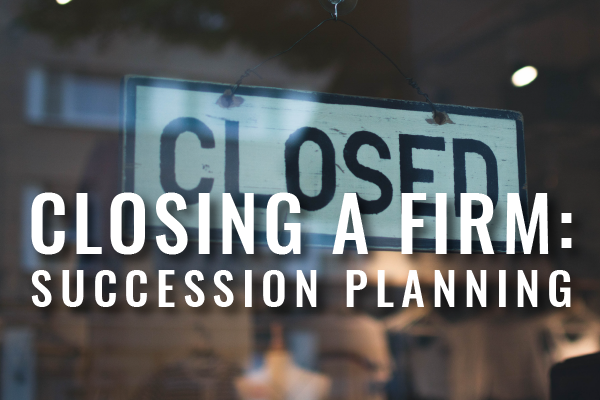When it’s time to close a law practice, you need to do it right — and you can ease the process for your future self with the right operations during the life of your practice.
Even if you don’t have plans to do so any time soon, preparing a succession plan for when the time comes to close your law practice — particularly if due to unforeseen circumstances — helps make the process as seamless as possible. Whether you are changing careers, retiring, or merging with another firm, there are many reasons why you might need to close up your law office.
With a plan in place, you’ll know exactly what needs to be done and how to do it within the confines of your fiduciary duties. You’ll need to build these five essential steps into your plan:
1. Notify Clients. First take stock of your open matters. For those matters that you have time to complete, do so. For ongoing matters that you cannot finalize, you must take necessary steps to ensure that your withdrawal does not have a “material adverse effect on the interests of the client.” Rule 1.16(b). As such, you should provide written notice of your intent to withdraw from representation. It is important to provide your clients with the opportunity to select new counsel, and adequate time to do so. For matters pending before a tribunal, you will need to obtain leave of court to withdraw from a matter.
2. Return Client Files. Whenever possible, return original files to clients. If you must retain certain original files, be sure to inform clients of where the files will be stored and who to contact to retrieve those files. For all other files, obtain informed consent from your client to destroy their files pursuant to the Professional Rules of Conduct. The simplest way to do this is by conveying your retention and disposition schedule to the client at the outset of the engagement via your fee agreement. For ongoing matters that require successor counsel, you’ll need consent from your client before transferring files to another law firm. You can find more on preserving client files in this post.
3. Protect Yourself and Your Family. Most (if not all) malpractice insurance policies are “claims-made”, which means the only policy that will protect you is one that is in effect at the time in which a claim is made against you for malpractice, not the policy that was in effect at the time the events occurred giving rise to the claim. Thus, you should discuss “tail” coverage with your malpractice provider. Many providers offer free tail coverage so long as you have had premium coverage in effect for a certain number of years (typically 2-3) and you retire altogether from the practice of law.
4. Account for Unearned Fees. For work that has and will not be completed, you must account to your clients for any unearned fees. Your trust account reconciliation records should provide the necessary information with regard to each client and the funds that remain in your trust account. If you cannot locate your client or cannot identify the owner of the funds, the funds will likely escheat to the IOLTA Committee (see proposed resolution currently pending before the SJC). For further assistance in closing out your IOLTA account, contact the IOLTA Committee or Board of Bar Overseers.
5. Notify the BBO. Finally, you should notify the Board of Bar Overseers of your new address, and if you are retiring, request inactive status.
Related Resources:
Find Checklists, Forms, and More on Planning, Closing, and Retiring here.
. . .
An earlier version of this post originally appeared in the Massachusetts Bar Association’s eJournal, and was published on our blog in 2014 as “Closing a Small Practice – The Short List,” which now redirects here.




